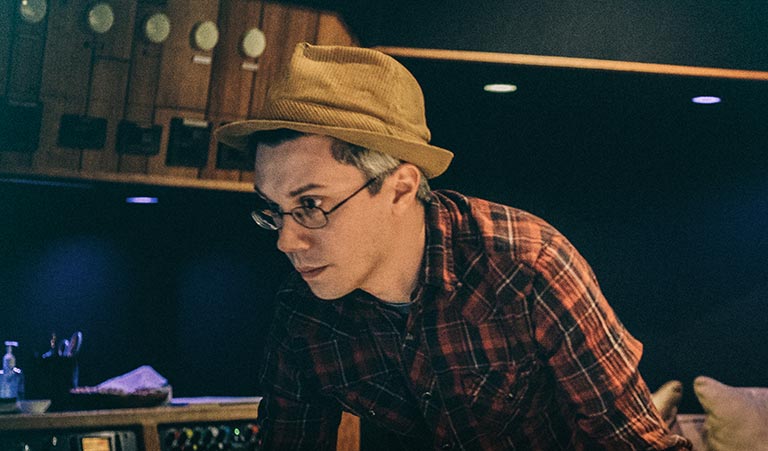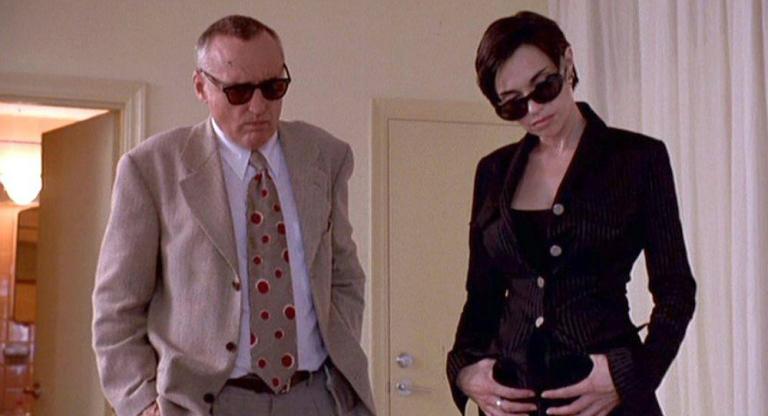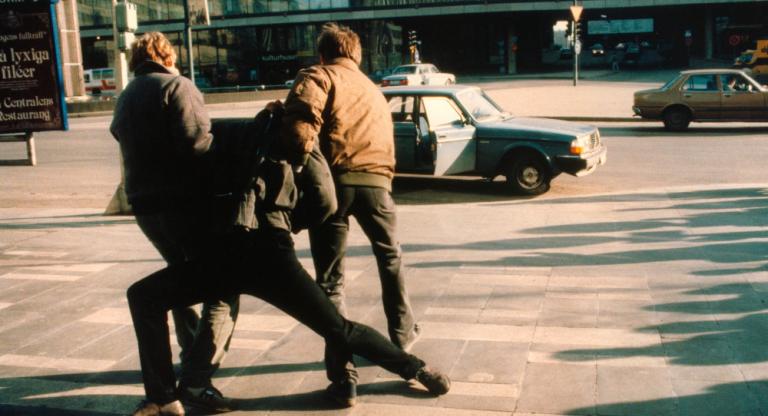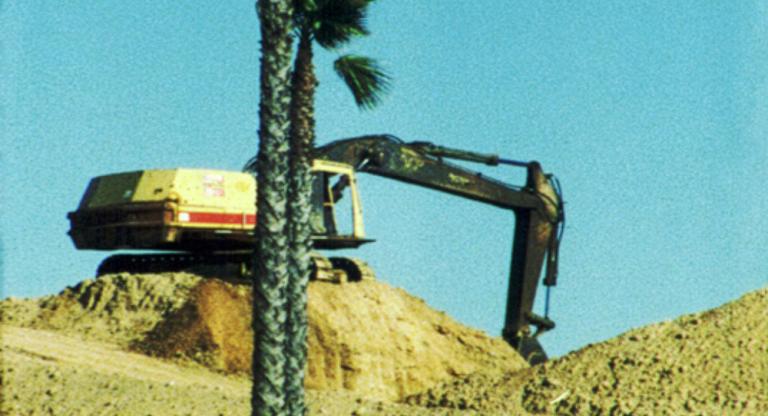Twin Peaks: The Return may be the only motion picture with a fan subculture devoted to its sound design – consider, for instance, the unique distinction of having a Twitter bot devoted to sharing closed caption descriptions of its soundtrack. It speaks to the way every cue and sonic texture is not only specific and integral to its storytelling, but singular and defying easy description.
David Lynch has shown rare prowess as a sound designer since incorporating sound elements into his early painting/audiovisual installations such as Six Men Getting Sick (1967). And in many ways, the carte blanche approach to The Return suggests the culmination of a period, inclusive of his web videos and INLAND EMPIRE, during which Lynch seemed uniquely emboldened to experiment outside the strictures of more "traditional" feature filmmaking.
During this time, Dean Hurley might be considered Lynch's righthand sound man, operating David Lynch's Asymmetrical Studio and collaborating on extensive projects—including as a re-recording mixer, supervising sound editor, and music supervisor, as well as co-writing and engineering records like Crazy Clown Time and The Big Dream.
On Tuesday, December 11, Hurley visits the New York City chapter of the Miskatonic Institute of Horror Studies to present The Frequency of Fear: The Power and the Glory of the Motion Picture Soundtrack at Greenpoint's Film Noir Cinema. As the description puts it, "Journeying through concepts of cymatics, standing wave levitation, musical tunings, as well as film examples, demonstrations, and dissections of modern mix sessions, The Frequency of Fear guides its participants through an awakening in understanding the spiritual power of sound both onscreen and beyond."
Last weekend, Hurley, recently relocated to his home state of Virginia, took the time to chat with Screen Slate about his career working with Lynch; the structure of traditional sound departments versus more hands-on approaches; how filmmakers can design scenes for dynamic sonic experiences; and the ability to tap into frequencies that ripple physical space–and, perhaps, open portals into other worlds. Our conversation has been condensed and edited for clarity.
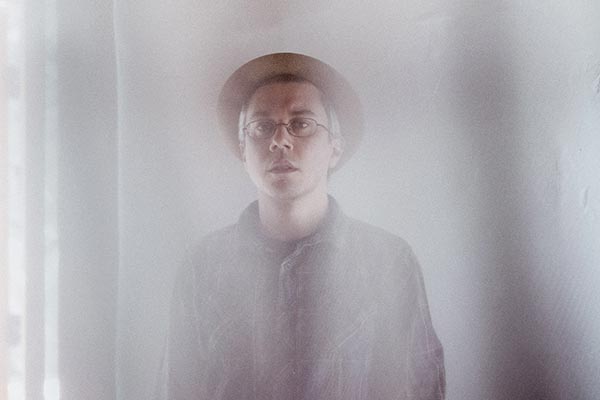
JON DIERINGER: I know you wore a lot of different hats working with David Lynch, and I wondered if you could start by talking through your various roles and how you initially began working with him.
DEAN HURLEY: I had known and done a job or two with Ron Eng, who is another sound supervisor and mixer, and he had worked with David on both Straight Story and Mulholland Drive. Through Ron I had learned that David had his own recording studio and was looking for a full-time engineer. I said I was interested, but honestly at that time, I wasn't really a qualified music recording engineer and it wasn't necessarily what I was interested in. But I thought, well, if nothing else, the interview alone would give me experience.
When I went for the interview, it was interesting, because even though Ron had described the job a certain way, David didn't talk about it in the same way at all. He just said 'well, I do a lot of experiments with sound up here and I do it all in this room...and I need someone to help run the room.' With that description of the job, it sounded infinitely more limitless and exciting than a more traditional role like music recording engineer. As I worked at that job for years and years and years, it really unfolded, blossomed and flourished many different skill sets and I ended up filling countless roles. It really became for me this unconventional trade that encompassed the entire gamut of sound and music making.
I'm getting the sense that working with David Lynch at that time was really different from a traditional post production environment, where roles tend to be very regimented.
Definitely. The way a typical Hollywood workflow has evolved over the years is that the audio workload is divided up between a number of different people, because you often need a fairly sizable team just to be able to deliver versions of a consistently evolving picture edit and be able to turn around temporary mixes for intermittent test screenings along the way...
That had just started to be ingrained in my head, and I was thinking 'this isn't exactly fulfilling, the way this is all diced up like this...' When I went to work for David, that mentality was basically inverted. David was doing everything and it was typically just me serving a wide variety of audio-based roles, and most importantly it was an arena where he didn't differentiate between music or sound...they were considered the same in a lot of ways. I started to realize - under David - the entire creative endeavor of constructing a motion picture experience, sonically, doesn't have to be as complicated as it is for the larger projects with committees of producers, test screenings and strict schedules.
I think what a lot of people respond to in David's approach is that he makes feature films and television in the same way he made his 16mm shorts as an art student. It's a singular approach to a big medium and his knowledge of each layer of the process allows for a uniform command over everything. Movie-making can be a kind of painterly experience, if one has a level of knowledge and command over all the disciplines involved.
Could you speak a little more to the kind of experimentation you undertook? Was this part of a routine process of creating and discovery, or were there specific projects you were working on?
Both...but from my perspective it would only make sense later with the context of what the projects became. Within the first few months that I started, there were these short shoots that were happening where David would say 'I've written a couple scenes that that I want to shoot this weekend.' It was the tail end of his davidlynch.com experiment, which was him falling in love with the internet – you know, rewind to the early days of when internet bandwidth finally got to the point where with you could stream a low-res quicktime, and the prophets of Silicon Valley had been preaching that with the internet everyone could have their very own television station...
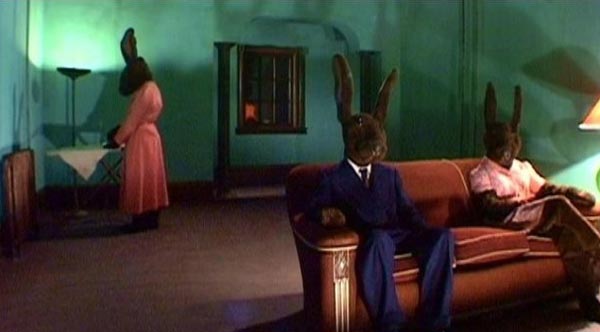
A few years before YouTube.
Yeah. I can't remember exactly when davidlynch.com initially launched, but I know that the idea was well before YouTube, and he was getting excited about that medium and the total freedom of that medium. I think it was like 2001 or something, I remember being in college and reading a filmmaking magazine article where he was sitting in his office teaching himself Flash animation. So there was this whole interesting period of output, because he started designing things for a website - short form videos, getting back to his roots of doing everything himself.
The rabbits. And the daily weather report, of course.
A bunch of things. So when I started in 2005, that was still going on, but I had no other way to process it except for, "Well, I guess this is stuff for the website." And I remember one time, there was a guy visiting from Digidesign, and he made a comment about the shoots being for David's "next feature." I thought at the time, "there's no way this is for a feature..." But that stuff started coming together, and he indeed assembled it all into INLAND EMPIRE. At the same time there were a lot of musical things that were being made. One of the very first songs that we recorded was "Ghost of Love," which ended up in the film, but initially was just simply another 'musical experiment.'
I think David's approach, which has always inspired myself and others, is the fact that he is constantly making. So from from a sonic perspective, there was this constant experimentation and generation of material, and ultimately any bit of anything could one day be the perfect element to use for a scene, a commercial, an album...who knows.
In mainstream filmmaking, there's a particular structure and process that people employ, and the idea of a more experimental approach, or a process of discovery, doesn't really figure into it.
I think a lot of that is economics. Flash forward to something like the third season of Twin Peaks – there aren't very many scenarios where a studio or company is just going to hand over millions of dollars to someone and say: "here, go and make something." The planet's filled with a lot of really interesting films, and some of the really good ones are made under these bizarre scenarios. And that's when the proverbial 'door to the next room that no one's discovered yet' comes forth – you get these odd scenarios that allow people to make something that is unique and removed from precedent.
Is there anything done with sound on The Return that posed particular challenges with broadcast guidelines?
Well, one example would be when we did the mix of "Part 8" with Penderecki playing over the atomic bomb...David just he kept saying, I want this really fucking loud, you know, and I'm thinking in my head 'dang, that's really at the mercy of how loud people are going to play this at home...that can't be controlled, plus nobody really has a home system that has fiberglass horns and 20" subwoofers.' When it came time to test the mix against loudness standards, it failed. It wasn't any particular monetary volume loudness, it was a loudness over time scenario, integrated LKFS. One of the solutions was to subtly distort the music, because then even at a low volume the harmonic saturation of the music is almost sending a signal to your brain to say: "this sounds distressed and therefore it must be loud," because it's breaking up ever so slightly. It wasn't a lot but it was enough to actually maintain the impression of the relative level that David was intending and also pass the loudness constraints.
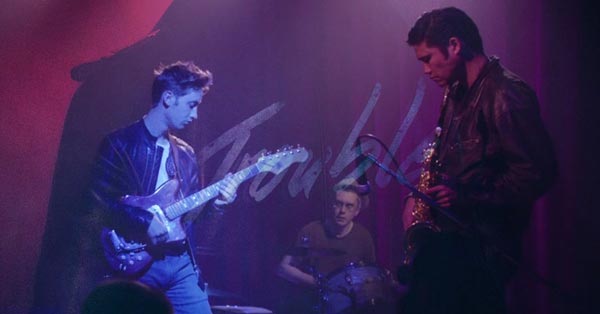
I wondered if we could pull back from your work with David Lynch a little bit and talk about your general approach to sound. You had mentioned some films you find especially noteworthy like Fearless (Peter Weir, 1993) and Last Days (Gus Van Sant, 2005).
What's fascinating to me right now, after 15 years of working professionally, is really diving in deep and understanding the universe around us and how our bodies and our mechanisms for hearing work, and understanding our world and how that plays into the things made for cinema. There's a really interesting, complex physiology of sound...sonic models that are biologically ingrained in us as animals that can trigger responses like fear.
Sound is a very emotional thing: emotion gets mixed into a cocktail of experience, and in tandem with our imagination it can actually change what and how we hear.
Fearless does that very well. Traumatic experiences – if you experience a car or plane wreck, for instance. The physiology of your bands of hearing and your natural muscle-driven compressor/limiters in your ears can really warp how events subjectively sound. Sometimes the first thing to go are those high frequencies. In the very beginning of the film, a plane has previously just crashed and Jeff Bridges is walking amidst the aftermath through this cornfield, and "Polymorphia," by Penderecki playing. It's this extremely low register abstract cello and bass portion of the composition. All the natural sounds of the leaves of the corn husks brushing past his arms are all muffled...it's a super subjective presentation of sound that allows the audience to hear things charged with the same emotion that the character is presumably hearing things.
Another prime example of this is the scene from Mulholland Drive with the character in back of Winkies. As soon as he's startled, his emotional state obviously pegs off the chart, and all the high frequencies disappear. Everything becomes distorted and muffled. It's a really fascinating way of not just thrusting viewers into that first person character experience, but an attempt at presenting sounds filtered through emotion.
Do you typically approach scenes thinking about the character's subjectivity, or are you trying to create a specific mood? Or does it just vary depending on the situation?
You have to approach it first and foremost through the story itself – is the story being told that way? It's not something that can be forced...It helps when the parties responsible for telling the story craft it in a way that lends itself to exploitable opportunities. 'Good sound' to me is like a musical composition, you know? If you've got guitars through your verse and your chorus and they're all cranked up to 11 and there's no frequency real estate left, you just have essentially white noise without any contrast potential. There's not a possibility to craft something in three-dimensions.
Even for scriptwriters, this is something to think about: something can be designed for a sonic experience. You can write a scene in a nightclub and it's loud, and then set another scene in a quiet room. But what happens if it's a walk through the nightclub, and ends just outside the nightclub – so you're going to get the dimensionality moving through the space, but then just outside the club we'll be left with only the 30 Hz rumble and then imagine what would happen if you're cross-cutting that with the quiet scene? You can craft and design something to be dynamic.
Truthfully, I don't think scriptwriters actually need to consider sound in that way, but when you're designing something that has dynamics, somehow the DNA of the idea is going to resonate and have a multitude of high order harmonics. I think there's a DNA strand in story ideas that allow themselves to expand in a large way and sound can take them to greater heights.
Do you think sound can enhance or smooth over an inherently flawed premise or execution of a scene?
What I have seen is sound can be an opportunity to change an intention and unlock something that previously hadn't necessarily been considered. It's hard to isolate and talk about any one ingredient independently, because it's really everything dancing with each other. There can be something on the script level that reads really good, and as it moves into production, there are actors to present dialog, a certain locale to present the script's idea of location, etc...things shift. And some of those things as written maybe aren't going to come across the exact same way. So when that is then in the editing room, it's another chapter of opportunity within the process. There is now control over performances and time and suddenly there are more tools to re-explore, chop things out, repeat lines of dialog, and extend beats of silence. As it gets to the soundtrack portion of things - with both sound and music - you have another opportunity to either further enhance, or to totally alter.
Sometimes even if you're designing things to have the opportunity to really jump and have incredible associative or dissociative kind of relationships that are three-dimensional and exciting, there are other times when you're simply trying to problem-solve and make something 'sound like a movie.'
What can people to expect you to talk about at Miskatonic?
I'm definitely going to start out walking people through some of the building blocks of audio, starting with just talking about frequency in general. We forget about it often, but the idea that audio frequency, visual frequency, even the physical matter around us is all vibrational energy resonating along a spectrum that is divided up by our various senses and beyond. When you get into that level of looking at how all this stuff is connected and how sound can be use to resonate and move matter — like videos of levitating particles of styrofoam and water droplets by using ultra-sonic frequencies, it's really fascinating stuff. And thinking about the cinematic experience of being in a room where you've got drivers, tweeters and subwoofers that are - if the room's tuned right - capable of producing 85-100 dB, these facilities can push air into a room of filmgoers and shift the molecules in our body and really ripple physical space, and these experiences become portals to another world. And I think that's super, super cool.
